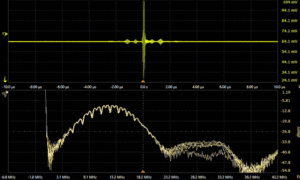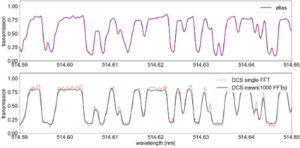
Our PhD candidate Tobias Hofer in front of the world’s most powerful dual-comb laser source.
Problem #1:
Dual-comb spectroscopy (DCS) usually uses two separate, low-power lasers that need active synchronization [1,2]. This has limited its practical use and the expansion into deep UV and VUV spectral ranges.
Solution:
What about using the recently well-established Kerr-lens mode-locked oscillators [3] and setting up a dual-output (dual-comb) thin-disk oscillator? The disk is large enough to accommodate multiple laser modes. Also, the alignment of a thin-disk oscillator with two outputs is significantly easier than the bulk oscillators. We pursued that project and pioneered this technology for the first time. The development resulted in the world’s most powerful thin-disk dual-comb oscillator [4]. Importantly, it turned out to be quite a practical system, being able to record the interferograms and show the comb lines in the spectral domain without any additional computational data processing or massaging. In other words, the system is simple enough to operate daily, record interferograms, and be used for spectroscopy experiments.

This video shows the interferogram recorded with our thin-disk oscillator-based dual comb system. No active stabilization is applied. What do you think? Is it impressive?
Motivation: Performing high-resolution spectroscopy in deep UV and EUV ranges. Making dual-comb spectroscopy simple and reliable and verifying the concept/approach of using thin-disk technology for the passive dual-comb oscillators.
The main credit for developing this system goes to Jonathan Brons, Maxim Yandulski, Tobias Hofer, and Kilian Fritsch.
Dual-comb spectroscopy. Future tool for breath analysis and atmospheric spectroscopy?
Problem #2:
Is dual-comb spectroscopy more powerful than Fourier Transform Spectroscopy or grating-based spectrometers? Here, we want to determine whether the dual-comb spectrometer can outperform Fourier Transform Spectroscopy and standard diffraction-grating-based spectrometers. Please keep in mind that multiple parameters need to be considered, and ultimately, it depends on the application which parameter range fulfills the requirements of this particular application. There is never a single technology that uniquely does everything. We have in mind two types of gas spectroscopy: deep ultraviolet and infrared spectroscopy.
Solution:
Start doing dual-comb spectroscopy and compare it to the available commercial devices. Tobias Hofer is doing the measurements in the near-infrared range, around 1030 nm, and also at the second harmonic of it, around 515 nm, trying to figure out the signal-to-noise characteristics of the spectrometer and its ultimate capabilities in terms of sensitivity and spectral resolution. In the picture below you can see the high-resolution spectrum of Iodine recorded with our dual-comb system around 515 nm and compared to the experimental data measured with a Fourier Transform Spectrometer [4].

Johann Meyer and Andrea Zablah, in parallel, work with a Fourier Transform Spectrometer (Bruker Vertex 80) and are setting up the infrared gas spectroscopy experiments with this source. Two spectroscopic approaches will be systematically compared for our applications.
Motivation:
Increasing the sensitivity of the optical spectroscopic measurements by 100-1000 times and keeping the whole instrument simple enough. Ultimately, we are developing an easy-to-use instrument for breath analysis to have early-disease detection based on this technology.
We already developed the most powerful dual-comb oscillator delivering Megawatt-level peak powers [4]. The dual-comb laser source converts extremely fast oscillating light electric fields (10^15 cycles per second) into the radio frequency range (10^6 cycles per second), where the signal can be detected in real-time with modern electronics. This method uses two superimposed pulse trains of laser pulses with slightly different repetition rates. Compared to complex, actively stabilized laser systems, the compact size of the laser system greatly simplifies
References:
[1] Fürst, L.; Kirchner, A.; Eber, A.; Siegrist, F.; Vora, R. di; Bernhardt, B. Broadband Near-Ultraviolet Dual Comb Spectroscopy. Optica 2024, 11 (4), 471. https://doi.org/10.1364/OPTICA.516783
[2] Coddington, I.; Newbury, N.; Swann, W. Dual-Comb Spectroscopy. Optica, 2016, 3 (4), 414. https://doi.org/10.1364/OPTICA.3.000414
[3] Pronin, O.; Brons, J.; Pronin, O.; Brons, J. Kerr-Lens Mode-Locked High-Power Thin-Disk Oscillators. In High Power Laser Systems; IntechOpen, 2018. https://doi.org/10.5772/intechopen.78620.
[4] (Fritsch, K.; Hofer, T.; Brons, J.; Iandulskii, M.; Mak, K. F.; Chen, Z.; Picqué, N.; Pronin, O. Dual-Comb Thin-Disk Oscillator. Nat Commun 2022, 13 (1), 2584. https://doi.org/10.1038/s41467-022-30078-0.
[5] To be added.
Letzte Änderung: 24. June 2024